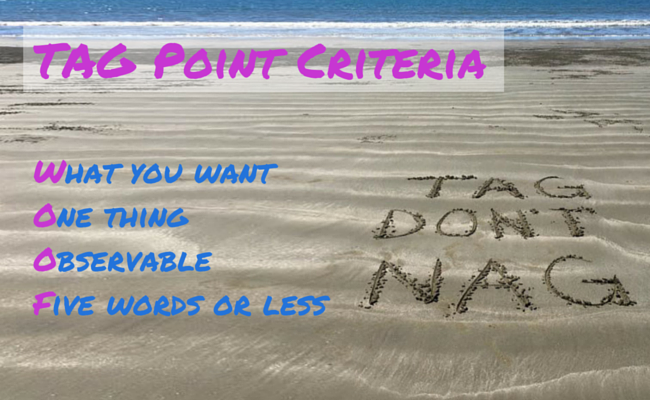Have you ever asked, “What’s the point?”
In TAGteach, we ask, “What’s the tag point?”
In TAGteach, the “tag point” is the absolute part of a behavior that, when performed, will receive the audible mark (tag). It is a specific physical movement that we want a learner to do.
For example, if a child is learning to climb up the stairs, we might set a tag point, “Foot On Step.” When teaching a child to write the letter V, the first tag point might be “Pencil on Top Line.” The tag point is the specific physical movement that will be tagged by an audible marker and that will result in reinforcement for the learner.
The child will hear the tag sound, know that he did the behavior correctly and will try to do it again correctly the next time.
 The tag point is what we look for and reinforce
The tag point is what we look for and reinforce
The tag point is the crucial component of TAGteach. TAGteach stands for Teaching with Acoustical Guidance. TAGteach is a teaching and communication method based on the scientific principles of Applied Behavior Analysis (ABA).
TAGteach enables extremely precise positive reinforcement of behavior by using an acoustical signal to “tag” a specific behavior (the “tag point”) – at the precise moment the child performs the behavior. This “precise moment” is the “tag point.” The behavior is “tagged” with an acoustical signal — a short, sharp sound made by a handheld device (the “tagger”). When the child performs the correct action, the parent/instructor immediately presses the button on the tagger and hands over a treat (candy, treat, token, praise, social recognition, or money) as a reinforcer.
Analyze and assess before setting a tag point
In a TAGteach setting, all instruction and learning centers on the tag point. The instructor sets a tag point based on the task involved and the learner’s skill level. Since the tag point is so important, it is worthwile to spend some time thinking about it.
The first part of developing a TAGteach lesson is task analysis and learner assessment. The instructor reviews the task to be taught and breaks it down into the smallest possible steps. The instructor then assesses the learner to determine whether the learner can achieve the tag point. The learner should always be able to perform the tag point. As much as possible, the instructor and learner should talk about the task and what the learner can do.
A tag point must meet these four criteria
Once the instructor and learner have settled on the first tag point, the instructor should review the Four Tag Point Criteria, to make sure that the tag point is as specific as possible.
The four criteria for a tag point are:
- What you want
- One criterion
- Observable and definable
- Five words or less
Check to see if your tag point meets all four criteria
Let’s check the tag point for teaching a child to climb stairs: Foot On Step:
- Is it what you want? YES. We want the child to place a foot on the step.
- Is it one criterion? YES. Foot on step is one action.
- Is it observable? YES. You can see when a child places a foot on the step.
- Is it five words or less? YES. Foot On Step is three words.
By reviewing the criteria, we know that Foot On Step is a good tag point because it meets all four criteria. It is clear and specific, we can see when the learner performs it. It is a single action, so as soon as the learner places a foot on the step, we can easily tag the behavior and give reinforcement.
Let’s look at a tag point that is not well designed. An instructor would like a child to clean up the toys in the play area. The instructor says, “The tag point is: pick up the toys, put them in the bin, and put the bin on the shelf.” Let’s do the tag point criteria review. Remember, the tag point must meet all four criteria.
- Is it what you want? YES. You want the child to do this complete clean-up task.
- Is it one criterion? NO. There are three separate actions.
- Is it observable? YES. You can see a child do these actions.
- Is it five words or less? NO. This tag point is sixteen words!
This tag point fails the criteria test. It is too long and complex. A tag point should be achievable for the child; with this tag point there is a likelihood that the child will fail.
Good tag points + precise reinforcement = success and learning
Setting a good tag point will help the child learn the skill. Once the child has mastered the first tag point, move on to the next step in process. With TAGteach, it is easy to reinforce behaviors precisely and quickly. The immediate, accurate feedback and positive reinforcement result in the child performing the correct action more often, and for longer periods of time. With immediate feedback and learning tasks broken down into small steps, children (and adults) can learn many new skills with TAGteach — at their own pace.
Video Example
Here is a video that illustrates the use of a tag point to help a child learn to print letters.
Learn More About Martha and TAGteach
With TAGteach, it is easy to reinforce behaviors precisely and quickly. The immediate, accurate feedback and positive reinforcement result in the child performing the correct action more often, and for longer periods of time. With immediate feedback and learning tasks broken down into small steps, children (and adults) can learn many new skills with TAGteach — at their own pace.
Learn More About TAGteach
For more information visit the TAGteach website
For research on TAGteach, please see the TAGteach Reference List
Join the free TAGteach For Learning and Behavior Facebook group here
See Martha’s book about TAGteach for Autism or feel free to ask me a question (with no obligation).
Click the button below to sign up for my mailing list and receive updates, new articles and free tips right in your inbox!
